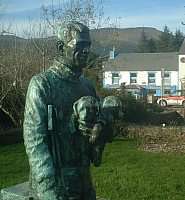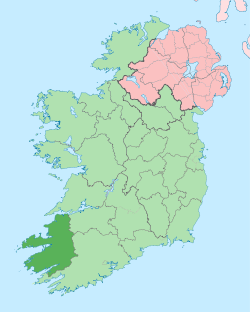Annascaul
| Annascaul Abhainn an Scáil | |
|---|---|
| Village | |
 Annascaul Location in Ireland | |
| Coordinates: 52°09′11″N 10°03′05″W / 52.152977°N 10.051289°WCoordinates: 52°09′11″N 10°03′05″W / 52.152977°N 10.051289°W | |
| Country | Ireland |
| Province | Munster |
| County | County Kerry |
| Population (2011) | |
| • Urban | 299 |
| Time zone | WET (UTC+0) |
| • Summer (DST) | IST (WEST) (UTC-1) |
| Irish Grid Reference | Q589019 |
| Website | www.annascaul-village.com |
Annascaul or Anascaul (Irish: Abhainn an Scáil / Abha na Scáil) is a village on the Dingle Peninsula in County Kerry, Ireland. It is situated 32.9 kilometres west of Tralee on the N86 Tralee - Dingle national secondary road near its junction with the R561 regional road to Castlemaine and Farranfore leading to nearby Inch Strand.[1] The village was recorded as having a population of 299 at the time of the 2011 census.[2]
Placename
Different suggestions as to the original meaning of the name include "Scáil's River" (Scáil Ní Mhúirnáin is a character in a local legend), "River of the Shadows", or "Ford of the Heroes".[3][4]


The late Tadhg Kennedy gave this explanation of the origin of the name in his submission to the Bureau of Military History of Ireland:
'The name of the village, Annascaul, is derived from the ford at that point where the road to Dingle leads across the river Scál and is a corruption of the word, Átha-na-Scáil, meaning, in English, the River of the Hero, and the hero being Cuchulainn whose grave is reputed to be on the side of the mountain above Droumavalla, north of Annascaul... There was a controversy in the "Leader" years ago about the meaning of the word Annascaul and I remember Dr. Douglas Hyde,"Beirt Fhear" (Mr. J.J. Doyle) and Mr. D.P. Moran, editor of the "Leader", visited Annascaul to carry out investigations locally into it. My grandmother determined it for them as Átha-an-scáil by the way in which she pronounced the word and her traditional knowledge that the lake, about two miles north of the village, is known as Loch-an-Scáil, and is traditionally associated with Cuchulainn, the legendary hero.'[5]
Geography

The Dingle Way walking route passes through the village.[6] Annascaul Lake is situated inland and just above the village.
History
The village is of relatively modern origins, having grown up around the beginning of the nineteenth century.[7] In 1837 it was described as:
"...containing 11 houses and 92 inhabitants. This place is situated in a pleasant valley on the new mail coach road from Tralee to Dingle, to each of which it has a penny post recently established."[8]
Annascaul was the birthplace of the Antarctic explorer Tom Crean, who was part of Robert Scott's ill-fated attempts to reach the South Pole and Ernest Shackleton's epic open boat journey from Elephant Island to South Georgia.[9] In 2003 a statue of Crean was erected in the village opposite the South Pole Inn, the public house he owned.[10] Irish American sculptor Jerome Connor, famous for his work the Nuns of the Battlefield in Washington D.C., was also born in Annascaul.[11]
There was a long history in the locality particularly around the late 19th and early 20th century of young men joining the British Royal Navy.[12]
Sport
Annascaul GAA is the local Gaelic Athletic Association club.
See also
References
| Wikivoyage has a travel guide for Annascaul. |
- ↑ "Google Maps". Retrieved 22 August 2013.
- ↑ "Settlement Annascaul (CSO Area Code ST 19005)". Census 2011. Central Statistics Office (Ireland). Retrieved 12 January 2014.
- ↑ Ashe, John (1949). Annascaul: Revisited and Reviewed. Melbourne: St. Finbar's Presbytery. pp. 7–11., transcribed at "Annascaul or Anascaul? The Name of The Village And What It Might Mean...". Annascaul Village. Retrieved 4 May 2014.
- ↑ Kennedy, Marie (2005). The Small Book of Annascaul (2 ed.). Annascaul: The Anchor. pp. 6–7.
- ↑ "Document No. W.S. 1413: Statement by Witness. Tadhg Kennedy (decd.)" (PDF). Bureau of Military History 1913-1921 (BMH) Collection. National Archives of Ireland. Retrieved 22 August 2013.
- ↑ "Dingle Way". IrishTrails. Irish Sports Council. Retrieved 22 August 2013.
- ↑ "Annascaul Local Area Plan" (PDF). Dingle Functional Area Plan. Kerry County Council. p. 108. Retrieved 4 May 2014.
- ↑ Samuel Lewis, ed. (1837). "ANNASCALL, or AUNASCALL". A Topographical Dictionary of Ireland. Retrieved 4 May 2014.
- ↑ Smith, Michael (2000). An Unsung Hero: Tom Crean – Antarctic Survivor. London: Headline Book Publishing. ISBN 0-7472-5357-9.
- ↑ Smith, Michael (2003). "Tom Crean (1877-1938) – an Irish hero". History Ireland. 11 (3). Retrieved 22 August 2013.
- ↑ "Jerome Connor". PBS. Retrieved 22 August 2013.
- ↑ MacDonogh, Steve (2000). The Dingle Peninsula (3rd ed.). Brandon. ISBN 9780863222696.
